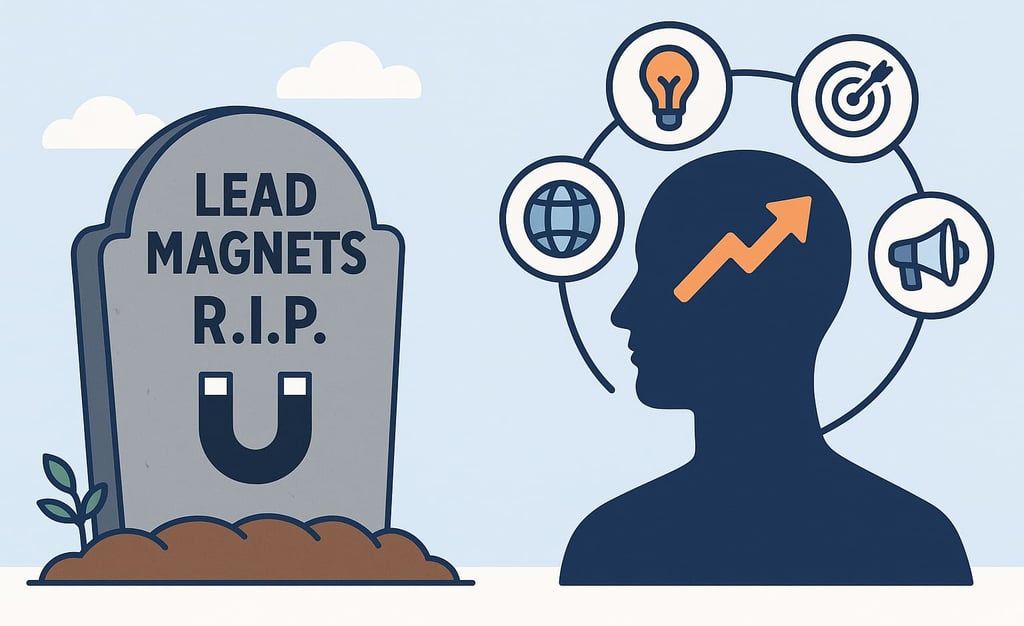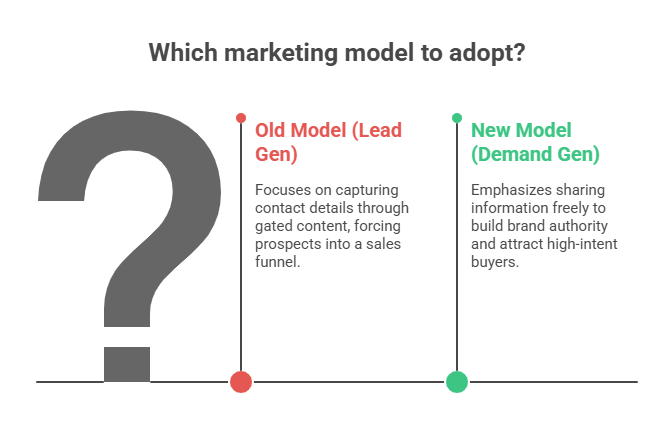AI Killed the Lead Magnet. Here's the Demand Gen Playbook for 2025
GROWTHSAAS
7/29/20256 min read


Introduction: The End of an Era, Driven by Data
For years, the B2B marketing playbook was simple: create a gated PDF, run ads, collect emails, and call it a funnel. In 2025, that playbook is not just outdated; it's actively detrimental to growth. This isn't an opinion – it's a conclusion based on an irreversible shift in buyer behavior, technology, and trust.
The debate between lead generation and demand generation is over. The data has declared a clear winner. If you are still building your marketing strategy around gating top-of-funnel content, you are optimizing for a world that no longer exists.
This playbook will dissect the inarguable data driving this shift and provide a strategic, actionable framework for what to do next.
Part 1: The Inarguable Data: Why the Old Funnel is Broken
Three powerful forces have converged to dismantle the traditional lead-gated model.
1. The Self-Serve Buyer is Dominant
Buyers are in control. They navigate the majority of their purchasing journey anonymously, armed with more information than ever before.
The Fact: According to research from Gartner, B2B buyers spend only 17% of their total purchase journey meeting with potential suppliers. When buyers are comparing multiple companies, the time spent with any one sales rep may be as low as 5%.
The Implication: Your buyers are forming their opinions, creating their shortlists, and often making their decisions before you even know they exist. Your website, your content, and your public reputation are your new sales team. Gating your best insights behind a form means you are absent for 95% of the sales process.
2. The AI Information Layer is the New Starting Point
The explosive growth of generative AI has fundamentally rewired how people access information.
The Fact: In early 2023, a UBS study reported that ChatGPT became the fastest-growing consumer application in history. This wasn't a fad; it was a permanent behavioral shift. In 2025, AI chat is the default starting point for complex problem-solving.
The Implication: Why would a buyer fill out a form for a generic eBook when they can ask an AI to provide a more detailed, customized answer in seconds? The opportunity cost of a lead magnet is now too high. If your expertise isn't visible and citable within these AI platforms, you are invisible to the modern buyer.
3. The Trust & Privacy Wall is Higher Than Ever
Distrust in digital marketing is at an all-time high, and technology is reinforcing this barrier.
The Fact: The widespread adoption of Apple's Mail Privacy Protection (MPP) has made email open rates unreliable. Google's ongoing deprecation of third-party cookies has kneecapped traditional ad retargeting.
The Implication: Buyers are actively seeking to protect their privacy, and the tech ecosystem is helping them do it. Asking for personal data upfront is now a high-friction, low-trust action. Brands that demand data before providing value are immediately positioned as self-serving.
Part 2: The Strategic Response: From Generating Leads to Creating Demand
Given the data, the only logical strategy is to reorient around a single principle: Trust.
Demand generation is a long-term strategy focused on building this trust by consistently providing high-value expertise with no strings attached.
Old Model (Lead Gen): Hoard your best information. Use it as bait to capture contact details. Force prospects into a sales-driven funnel.
New Model (Demand Gen): Share your best information freely. Use it to build your brand's authority and educate the market. Attract high-intent buyers who approach you when they are ready.


This isn't about abandoning goals; it's about achieving them more efficiently. A lead generated from a place of trust and brand authority is infinitely more valuable than one captured through a transactional gimmick.
Part 3: The Modern Playbook: Executing High-Performance Demand Generation
This framework is built on three core pillars. This is the exact playbook BriskFab uses to help B2B startups build an authoritative brand that attracts high-intent buyers, moving them from obscurity to industry dominance.
1. Publish Definitive, Ungated "Pillar" Content
Create comprehensive resources that solve your ideal customer's most pressing problems. These should be free, accessible, and positioned as the best answer on the internet for that topic. Think ultimate guides, data-rich analyses, and expert-led tutorials.
2. Master AI Discovery (GEO/AIO)
Ensure your expertise is visible where buyers are looking. This requires:
Structured Data: Use schema markup (FAQ, How-to, Article, Person) to tell AI models exactly what your content is about.
Answer-First Formatting: Structure your content with clear headings and concise, direct answers that are easy for AI to pull and cite.
Building Topical Authority: Create clusters of related content to signal deep expertise in a specific niche.
3. Build a Brand with a Verifiable Point of View
In a world of synthetic content, your unique perspective, backed by real people and proprietary data, is your ultimate moat. This includes scaling high-value assets like AI-powered video that communicate your expertise in a uniquely human way.
Part 4: The Strategic Role of Gated Content in 2025
Gated content is not completely dead, but its role has pivoted from top-of-funnel bait to bottom-of-funnel conversion. You should only gate an application, not information.
Gate these:
Product Demos & Trials: The ultimate high-intent action.
Interactive Tools & Calculators: Assets that provide personalized value AI cannot replicate (e.g., an ROI calculator).
Proprietary Data Sets: Allow users to download the raw data from your public reports.
Sales Consultations / Strategy Calls: A direct request to speak with an expert.
These are not "lead magnets." They are conversion points for buyers who have already consumed your ungated content and trust your brand.
Part 5: The New Scorecard: Measuring What Actually Drives Revenue
Stop celebrating MQLs. The metrics that matter today are tied directly to brand authority and business impact.
Leading Indicators (Demand Health):
Branded Search Volume Growth
Direct Traffic
AI/Search Engine Citation Volume
Engagement on ungated content (time-on-page, scroll depth)
Lagging Indicators (Business Results):
Pipeline Value Generated from Inbound Channels
Sales Cycle Velocity (how fast deals are closing)
Customer Acquisition Cost (CAC)
Conclusion: The Opportunity is Yours.
The shift away from the traditional lead magnet funnel isn't a choice for marketers to make; it's a reality created by our buyers and the technology they use. The data is unequivocal. Brands that build trust by freely sharing their best expertise will attract the highest-quality buyers and win. Those that continue to hide their value behind a form will become increasingly invisible. The playbook is clear. It's time to execute.
If your organization is ready to move beyond the broken lead generation model, the team at BriskFab can help you design and execute the data-driven demand engine this new era requires.
Frequently Asked Questions
What is the main difference between demand generation and lead generation?
Lead generation is a transactional strategy focused on capturing contact information, often by gating content behind a form. Demand generation is a relational strategy focused on building trust and authority by providing high-value, ungated content to educate a market. The goal of demand gen is to make your brand the obvious choice when a buyer is ready to purchase.
Are all lead magnets useless in 2025?
No, but their role has fundamentally changed. Gating general information (like eBooks or whitepapers) is no longer effective for most businesses. However, gating high-intent applications at the bottom of the funnel is still a powerful strategy. This includes product demos, free trials, custom ROI calculators, or consultations where the user is requesting a direct, personalized interaction.
What are some examples of effective ungated content for B2B?
The most effective ungated assets are things that AI cannot easily replicate. This includes proprietary industry reports with original data, in-depth video tutorials featuring your top experts, comprehensive "how-to" guides with unique insights, and free tools or templates (e.g., Notion playbooks, Figma templates) that solve a tangible problem for your audience.
What is the difference between GEO and AIO?
GEO, or Generative Engine Optimization, is the tactical process of making your content technically readable and citable by AI models. This involves using structured data and clear formatting. AIO, or AI Optimization, is the broader, holistic strategy of making your brand the most trusted and authoritative source on a topic in the AI's "knowledge graph." AIO encompasses GEO but also includes publishing first-party data, building expert profiles, and creating a multi-format content ecosystem.
How do you measure the ROI of a demand generation strategy?
You shift focus from top-of-funnel vanity metrics like MQLs to bottom-line business impact. Track leading indicators like growth in branded search traffic and AI citations. Then, correlate that brand growth to lagging indicators that your CFO cares about: an increase in qualified inbound pipeline value, a decrease in sales cycle length, and a lower overall customer acquisition cost (CAC).
